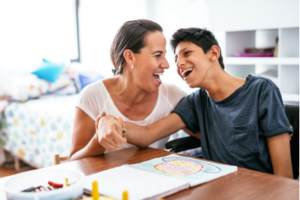Celebrating Learning Disabilities Week 2022
It is Learning Disability Week 2022, a week dedicated to understanding, listening to, and celebrating the experiences of people with learning disabilities.
Every year, this awareness campaign aims to highlight the realities of living with a disability. It comes at a vital time as we continue to learn to live with the aftermath of the pandemic. This week is seen as an opportunity to make sure the world hears what life is like for individuals who have a learning disability. Between June 20 – 26th, the theme for this year’s learning disabilities week is ‘Art and Creativity.’ After the challenges of the last year, lots of people have had to get creative to stay connected.

Different people experience disabilities differently, and the phrase ‘learning disability’ describes a broad range of different abilities. It may be necessary to provide support during certain activities – a student with a learning disability might have difficulties reading or writing.
Learning Disability Week is organised every year by the learning disability charity Mencap. It aims to improve the quality of life for individuals with learning disabilities by raising awareness about important issues, fighting stigma and discrimination, and raising funds for outreach and support programs. As such, Learning Disability Week will be close to the hearts of many teachers, parents, and other educators.
Mencap has stated that they ‘want to show how people with a learning disability are reconnecting with friends and their communities.’ Additionally, they ‘want to talk about the issues many people still face after the end of COVID restrictions, like still having to isolate or dealing with poor mental health and anxiety.’
Statistics around Learning Disabilities in the UK
There are almost 14 million disabled people in the UK. That’s one in five of us. Many feel that the pandemic has shone a harsh light on the inequalities that still exist in our society today:
- In 2020, 1 in 4 disabled people reported feeling forgotten by the government.
- People with a learning disability are twice as likely to experience mental health problems.
Physiotherapy, hospital procedures and social care plans for people were cancelled or delayed during the pandemic. Many argue that further action is needed to review the support that is available so disabled people can access the care and essential services needed at home.
How to get involved with Learning Disability Week
Below are just a few ways in which you can get involved this year:
- Twinkl has a range of resources available for KS1 and KS2.
- The Open University have compiled a fantastic range of videos and lesson resources across a wide range of curriculum areas, including lessons on ‘challenging disablist language’ and ‘barriers then and now.’
- Mencap has a number of ways you can get involved with the cause, as well as pathways to get support should you need it.
- Sign up for free to receive Mencap’s Learning Disability Week fundraiser pack.
- Many local NHS practises are hosting events like this one at Sunderland’s Stadium of Light.
- Other localised initiatives include Wakefield council inviting people with disabilities to contribute to their online art exhibition.
Advice for Teaching Children About Learning Disabilities
The benefits of starting early cannot be overstated. Often around the age of four, children will start noticing how people around them are different from them. This should be used as a springboard for discussion. Let children be curious: children are always learning, even if you are not consciously teaching them. So let’s make sure they get the right information when exploring how people can be different from each other.
Focus on a disabled person’s strengths through discussion. Create understanding among students and their peers that learning disabilities are related to a wide range of ability levels. Allow children a safe place to ask questions. This avoids creating fear-based negative feelings in the future.
How to Move Past Awareness and Towards Acceptance with your Students
This is a really important distinction to make. Rather than simply pointing out that disabled people are a part of our society, we must eliminate any negative associations that might exist by teaching acceptance. Acceptance and inclusion of all people is necessary regardless of physical or learning disability.
Ensure as an educator that you are confident in using the correct terminology. This useful guide from the DfE is helpful to ensure we are not tip-toeing around when opening up the dialogue with our students.
Lesson time can be used to explore how we all do things in different ways. Some people can’t see and use a walking stick or guide dog, some people use a wheelchair to get around. Talking about disabilities in a positive and matter of fact helps children to accept all the ways that people can be different.
Thank you for reading our post on learning disabilities week 2022. Let us know how you are marking the week, we’d love to hear from you! If you are interested in a teaching position within SEND education we welcome you to reach out to the team or browse our latest vacancies. Contact SEN@prosperoteaching.com to let us know how we can help with your SEND staffing needs.
Additionally, if you are a mentor or tutor with an interest in supporting students with their learning at university, get in touch with the Prospero Student Support Services team.
Teaching Blog
No results found.....